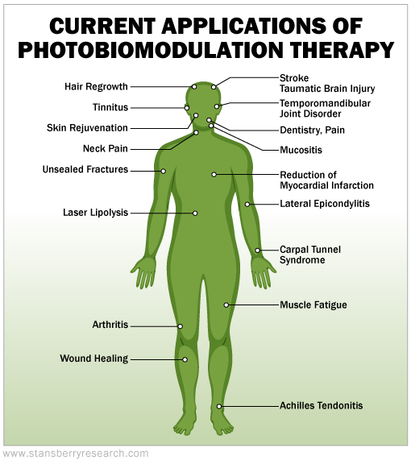 In the 1860s, Florence Nightingale taught her nurses about the importance of being exposed to fresh air and sunlight during convalescence. It is fitting to highlight one of the many health benefits Florence Nightingale advocated during this week as it is National Nurses Week. Her birthday is May 12th as well, marking the end of the Nurses Week. Flash forward to today where 93% of our time is spent indoors. There is now more than ever a greater need for supplements or other therapies to make up for some peoples lack of time with natural light. That or find the time to get out more. Light therapy is used by some healers – in different forms – to treat a variety of ailments... For instance, photobiomodulation therapy – which targets the regenerative properties of cells in the body. Turns out, the body has three pathways by which it uses light: through the eyes and vision, through a non-visual optic path, and via photobiomodulation as detailed below:
The chart to the left shows all the possible treatment targets using photobiomodulation therapy. Essentially, light can be used to help you regrow hair, heal wounds, reduce pain, and even rejuvenate the skin. Light therapy is commonly used as a treatment for seasonal affective disorder ("SAD"). SAD is a form of depression that occurs as the result of lost sunlight exposure during the winter months. SAD is generally experienced as moodiness and the loss of energy. More than 10 million people in the U.S. experience SAD. To counteract the lack of sunlight received during the dark winter months, people can use light therapy lamps at home or in the office. This technique is called bright light therapy. Spending just 20 minutes a day sitting in front of a sun lamp is known to have great effects on people's mood and levels of depression. Bright light therapy mimics the sunlight through a lamp. Spending 15 to 30 minutes in bright light – at least 10,000 lux – stimulates your retinas, which then activates the hypothalamus. The hypothalamus then regulates your circadian rhythm (your sleep-wake cycle). The exposure to bright light also stimulates the production of melatonin (also used in the circadian rhythm cycle) and regulates the use of serotonin (which regulates your mood). A 2020 study published in the Public Library of Science found that bright light therapy is also an effective treatment for bipolar depression. A total of 12 studies were included in this meta-analysis and a total of 847 patients with bipolar depression were examined. Using bright light therapy to treat bipolar depression usually yields quick results, whereas many medicines can take a month to build up in the system enough to have an effect. Bright light therapy has been found to be an effective treatment for people with Parkinson's disease who are experiencing sleep disturbances and depression. It also has been shown to improve motor function in people with Parkinson's. Additionally, bright light therapy is helpful for people experiencing panic disorder or post-traumatic stress disorder ("PTSD") and who are also being treated with exposure-based cognitive behavioral therapy. While we have fantastic technology these days to use light to our advantage, getting full spectrum natural sunlight is still very important. Here are seven ways we can practice getting more good light to support our general health and well-being... 1) Use halogen or incandescent bulbs – they are the closest to broad spectrum daylight. 2) Avoid fluorescent and compact fluorescent lamp ("CFL") bulbs – because they are prone to flickering, emit UV radiation, and contain mercury vapors that can escape if the bulbs are broken. 3) Choose "warm white" light emitting diode ("LED") bulbs – using them will minimize the effect of harmful blue light. You can find these warm whites at the grocery store or online – wherever you're buying your bulbs. Household LEDs generally are sold at 6 watts. 4) Avoid fluorescent and LED bulbs with excessive flickering – they cause unnecessary stress. 5) Avoid light sources in your bedroom at night, especially electronics. 6) Spend as much time as possible outdoors in daylight, especially in the winter. 7) Expose yourself to daylight without your glasses or contact lenses on. Letting the light hit your eyes without a barrier allows for better absorption of the sun's rays. The great news is that spending time in the sunlight is a very low risk activity. Some risk is associated with being exposed to ultraviolet light – which in large enough doses is linked to skin damage, retina damage, and accelerated aging over long periods of time. Otherwise, being bathed in the light of the sun is essential to your health and well-being. Not only will you be healthier, but you will find yourself happier as well. They don't call it a "sunny disposition" for nothing. Portions of this article were an extract from Doctor Eifreg (Optometrist).
0 Comments
Leave a Reply. |
AuthorMartin Luther King Jr. said "Life's most persistent and urgent question is, 'What are you doing for others?'" Archives
August 2023
|

 RSS Feed
RSS Feed